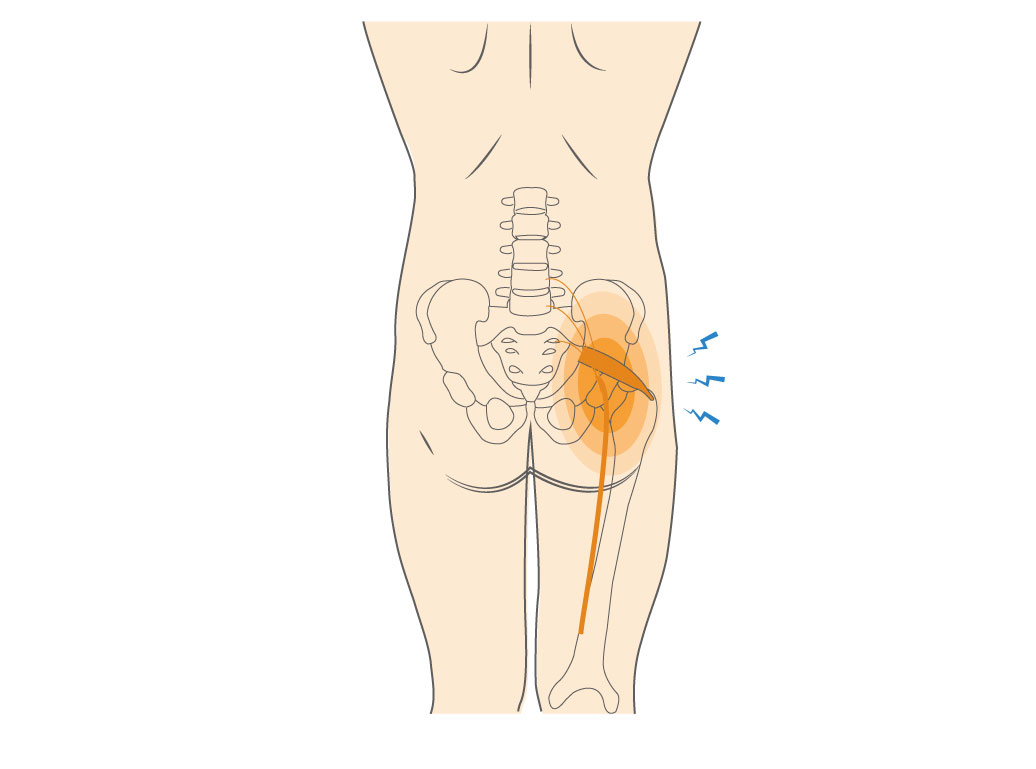Piriformis syndrome is a rare pain disorder that involves the narrow piriformis muscles located on either side of the upper buttocks. The muscle’s primary purpose is to rotate the hip externally — i.e. turning the hip so the knee points away from the other leg. The sciatic nerve is a large nerve that runs from the lower back down the back of the legs. In most people the sciatic nerve passes behind the piriformis, but in some it goes through the piriformis. If the piriformis presses on the sciatic nerve, the nerve can become compromised, resulting in severe pain.
Piriformis Syndrome Causes, Symptoms & Treatment Options
Piriformis syndrome is a rare pain disorder that involves the narrow piriformis muscles located on either side of the upper buttocks. The muscle’s primary purpose is to rotate the hip externally — i.e., turning the hip so the knee points away from the other leg. The sciatic nerve is a large nerve that runs from the lower back down the back of the legs. In most people, the sciatic nerve passes behind the piriformis, but it goes through in some. If the piriformis presses on the sciatic nerve, the nerve can become compromised, resulting in severe sciatic nerve pain.
Overview
Overview

What causes Piriformis Syndrome?
Every time you move your lower body, the piriformis muscle is involved. This muscle can become irritated and inflamed due to overuse. This can cause the muscle to spasm or swell, putting pressure on the sciatic nerve. A direct trauma to the muscle, for example, due to a fall in sports, can also cause piriformis syndrome and result in muscle spasms and buttock pain.
Piriformis syndrome is most common in these sports:
• Running
• Soccer
• Lacrosse

Symptoms
Piriformis syndrome typically causes pain on one side of the lower back, in the buttocks area. Common symptoms also include:
• Pain that gets worse when walking, running, climbing stairs, or sitting for long periods of time
• Buttock pain that gets worse when walking, running, climbing stairs, or sitting for long periods
• Tingling or numbness in the legs and calves
• Difficulty sitting
When to see a doctor
Athletes with symptoms of piriformis syndrome should see their doctor if their symptoms persist for several weeks. At your visit, you will be asked to describe your symptoms and physical activity. A physical examination will include evaluating the range of motion in your hip and back. Your physician will perform other physical examination tests to rule out other conditions.
Diagnosing piriformis syndrome can be challenging. Doctors frequently use imaging tests, such as X-rays and MRI scans, to rule out other causes of symptoms. These tests may be ordered to rule out sciatica (sciatic nerve pain) or problems with your hip, like hip pain, tendonitis, arthritis, or stress fractures.
Non-operative treatment
Treatment of piriformis syndrome usually involves avoiding activity that aggravates pain. This may involve resting from sporting activities or avoiding sitting for long periods of time. Conservative treatments may also include:
• Nonsteroidal anti-inflammatory drugs (NSAIDs), such as ibuprofen and naproxen, to relieve pain
• Muscle relaxants to relieve pain and muscle spasms
• Applications of moist heat
• Physical therapy exercises and piriformis syndrome stretches can help you to strengthen muscles and improve flexibility.
In some cases, an ultrasound-guided corticosteroid injection may be helpful for relieving pain. For cases of severe pain, your doctor may recommend electrical stimulation of the muscles to block pain.
Try these exercises to help address your condition:
Below is a PDF of the Exercise Program
Surgical Treatment
In rare cases, when conservative treatments are not effective, your doctor may recommend surgery to release the piriformis muscle.
Recovery
Your doctor may advise limited activity during your recovery period. Oftentimes, piriformis syndrome may take many weeks to resolve. Your doctor and physical therapist will work with you to develop an exercise and piriformis syndrome stretch program to help get you ready for a full return to play while reducing the recurrence of sciatic nerve pain, hip pain, and buttock pain.
GET BACK TO WHAT YOU LOVE. FASTER
Sources
https://www.spine-health.com/conditions/sciatica/what-piriformis-syndrome
https://www.webmd.com/pain-management/guide/piriformis-syndrome-causes-symptoms-treatments#1
http://jaoa.org/article.aspx?articleid=2093614
https://www.ninds.nih.gov/Disorders/All-Disorders/Piriformis-Syndrome-Information-Page
https://medlineplus.gov/ency/patientinstructions/000776.htm
Frequently Asked Questions
Why is piriformis syndrome controversial?
Diagnosing it isn’t straightforward—physical tests exist, but their reliability is debated. The link between piriformis muscle issues and sciatic pain was first noted in 1928, yet research still lags.
What are the six classic results of piriformis syndrome?
Robinson coined the term in 1947, listing key signs:
- Injury to the sacroiliac/gluteal area
- Pain radiating from the sacroiliac joint, sciatic notch, or piriformis muscle, often making walking painful
What triggers piriformis syndrome?
Symptoms often worsen after sitting too long, walking, or running. Relief usually comes when lying flat. The exact cause? Still unclear.
What are the common symptoms and challenges in diagnosing piriformis syndrome?
Symptoms include aching or pain in the thigh or buttock, pain that improves with rest but worsens with activity, and tingling or numbness in the legs. Diagnosing piriformis syndrome is difficult because physical tests aren’t always reliable, and research on its causes and links to sciatic pain is still limited.

